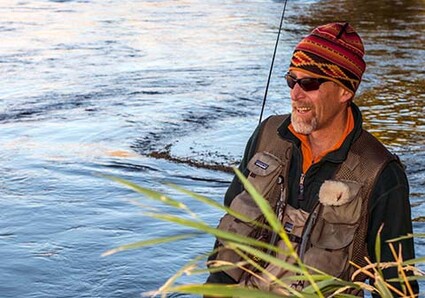A passion for Central Oregon’s landscape
Last updated 5/4/2021 at Noon

Brad Chalfant explored Deschutes Land Trust Preserves in the company of Sisters naturalist Jim Anderson. photo provided
Following in the tradition of men in his family becoming attorneys, Brad Chalfant enrolled at Northwestern School of Law at Lewis & Clark College in Portland after graduating from the University of Kansas.
“The first day of law school I knew I wasn’t interested,” Chalfant admitted.
Tradition pushed him to stay the course, graduate, and go to work for a firm where he handled mostly bankruptcies.
“I was miserable,” he said.
Over a single-malt with his best friend, a decision was made.
“The next day I gave my notice. Two weeks later I was ski bumming at Mt. Bachelor,” he said.
Chalfant went to work in the Deschutes County Planning Department, managing the County’s real estate. He had a notebook full of properties and a pickup truck, which afforded him the opportunity to become very familiar with the land within the County.
“I am here today because of Tom McCall (former governor of Oregon),” he explained. “I saw the Northwest as this mythic place, and I didn’t want to see my vision of nirvana destroyed. I liked Oregon’s land-use system [aimed at preventing urban sprawl and protecting farm and forest lands].”
While having a beer at Deschutes Brewery in the 1990s, a conversation turned to the idea of starting a land trust — a fairly new concept — and the idea took hold.
Chalfant and others started pulling together influential people who shared their enthusiasm for the land trust concept.
Among that early group was The Bend Bulletin’s Bob Chandler, who was one of the founders of the Oregon Community Foundation, Willamette Industries’ chairman Bill Swindells, as well as Bend real estate attorney and civic leader Win Francis.
Mike Hollern of Brooks Resources and Bill Smith of William Smith Properties acted as advisors.
Around the same time there was a similar group forming in Sisters, including Maret Pajutee, Russ Olson, and Bill and Gretchen Dakin, who eventually joined the Bend group.
Jim and Judy Knapp, who owned Indian Ford Meadow, wanted to donate the meadow to an organization by the end of 1995. They chose the newly incorporated Deschutes Basin Land Trust as the recipient. Because their nonprofit 501(c)(3) status hadn’t come through yet, the Oregon Community Foundation received the land from the Knapps and held it until the nonprofit status for the Land Trust was granted.
Thus, began the Deschutes Basin Land Trust (now the Deschutes Land Trust) with Chalfant as the first chairman of the board. Francis convinced the board to hire Chalfant as their first executive director.
“I’d found my passion,” Chalfant said.
Now, 25 years later, Chalfant is stepping down after a quarter century of encouraging the protection of vital environmental and wildlife-habitat lands throughout the entire Deschutes River watershed, covering 11 counties and 6.4 million acres, 60 percent of which are public lands.
“We have tried hard to be strategic in our planning for areas experiencing development pressures,” Chalfant said.
There are currently a dozen preserves from Indian Ford Meadow to the Metolius Preserve, from Whychus Canyon to the Priday Ranch. They also manage a number of conservation easements on privately owned property.
Land Trust staff and volunteers lead guided, educational hikes and work parties on the preserves. Outdoor school labs engage students in activities to encourage appreciation of the land and the importance of protecting it for future generations.
Talking with a humble Chalfant is like a course in the environmental history of Central Oregon. The process of securing, restoring, and maintaining the preserves could fill multiple books.
Whychus Creek has been brought back to life, able to support the first returning fish in decades. The Camp Polk Meadow multi-year restoration (one of Chalfant’s favorites) is an inspiring tale of a once-dead meadow with a trenched creek having its ecological function restored by remeandering Whychus Creek through its original flood plain.
The three-year project included adding a mile to the main channel of the creek, and four miles to the side channels. Community groups came out to do portions of planting 180,000 plants, seeding the meadow, and placing 1,800 logs to slow down the water and trap sediment. According to Chalfant, community involvement in the Land Trust projects creates a sense of ownership by the participants.
Chalfant told the story of an eight-year-old girl, talking about planting willows and cottonwoods in the meadow and hoping someday she can bring her kids out to see her grove.
“That’s what it is all about,” he said.
The Land Trust is currently working with several large Central Oregon ranches to create conservation easements along creeks where livestock grazing is moved away from the creeks, which can then be remeandered to create wildlife habitat if needed.
As Chalfant said, “I hope the Land Trust can conserve 50-, 60-, 70,000 acres of big ranches. The Land Trust doesn’t have to own everything. The ranchers can provide easements. They can be strategic by taking the long view.”
What Chalfant’s passion, drive, and dedication have set in motion, to the benefit of greater Central Oregon, will be passed on to a new executive director who might work with the Land Trust board to identify “different projects to be more relevant to the community. It has become clear it is time for new energy.”
The man who has cared for the land for so long and dedicated his life to conserving special places for future generations, is fully relinquishing his Land Trust duties and responsibilities, including as the Land Trust representative on the Deschutes Trails Coalition. Although this decision is bittersweet for Chalfant, the relationships he has formed with the people with whom he worked have been the “honor and privilege of my life.”
“I’ve had a good 25-year run. For a recovering attorney, it’s been a pretty good run,” he concluded.
Although he has not announced any definite plans for what is next, Chalfant does promise to stay involved with conservation. He can probably be found backpacking, skiing, cycling, and being outside with his wife of 14 years, Dr. Brenda Johnson.


















Reader Comments(0)